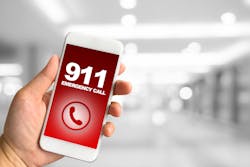Emergency communications predictions for a post-COVID world
The past year has brought more innovation, technology, and open lines of communication to public safety than ever before. We have seen the NextGen911 initiative gain traction and some states deploy emergency communications technologies in every public school. However, the influx of 911 calls that were made at the beginning of the coronavirus outbreak clearly displayed how strained and outdated systems truly are. Despite the progress we’ve made, the COVID-19 pandemic is proving time and again that we still have work to do to upgrade emergency communications.
As we begin to think about what the world could look like after the pandemic, public officials and residents continue to demand more and better methods of communication, especially in the moments it matters most. Here are some key trends public safety agencies, schools and vendors can expect to see post-COVID-19:
A renewed focus on interoperability and collaboration:
Leading emergency management agencies were already coordinating with local businesses and schools to leverage private emergency assets or identify risks before the outbreak struck. As both sides recognize the value of this coordination during the pandemic, it’s likely we’ll see greater collaboration between different agencies, departments and other institutions moving forward.
After the coronavirus outbreak has subsided, more schools and businesses will work closely with law enforcement and 9-1-1 to collaborate on safety and communication plans and ensure lines of communication are open. We will see an adoption of more technologies that enable agencies to better communicate across key community stakeholders, as well as with other agencies, ensuring that everyone is on the same page and has the latest information.
Continued debate over the balance of privacy vs. public safety:
With Google and Apple announcing that they could use data from phones to trace and track the spread of the coronavirus, many people are concerned with how their data will be used, stored and protected. Because of the uncertainties surrounding personal data, many individuals will be leery about sharing personal information for fear it will be sold or compromised – or, in the case of the virus, used against them.
While the concern is obviously understandable, it’s crucial for public safety agencies to have access to sufficient information so they are better equipped to respond to emergencies. From identifying potential threats to leveraging vulnerable needs databases to help communities and individuals evacuate during an emergency, a lot of good can be done with this information. Thanks to new technology, residents can easily and voluntarily sign up for programs and apps that provide lifesaving information to appropriate officials. These programs allow residents to give first responders and emergency management officials critical information, such as medical conditions, emergency contacts and other important intel that allows them to respond quickly and more effectively if a disaster strikes.
Faster detection of indoor location:
Emergency officials not only need to know what they are walking into but also the precise location of the emergency. Over the past few years, location-based services and accuracy have improved, but being able to pinpoint what building, floor or even room is involved in an emergency saves first responders valuable time during a response and also provides the most direct route to the individual in need of assistance, which can limit exposure to the coronavirus or the next infectious disease we are faced with.
With new FCC benchmarks being put in place this year, we’ll likely see faster and more accurate detection of indoor location, getting first responders the precision they need to execute a quick response. Once 911 can reliably and consistently pinpoint a more precise location within a structure, the next phase will be making that information actionable. For example, if 911 knows that a person is in distress on the fifth floor of a ten-story building, they also need to know the quickest way to get to access the office or apartment the person is located in, as well as whether there any physical barriers to reaching that location. By quickly matching the precision of location with floor plans or site layouts, 911 and first responders can know exactly where a call is coming from inside a building and how to get to the location, making for a quicker response.
The more information residents can provide to 911 and first responders, the quicker, more informed, and efficient response can be. As a result of the outbreak, residents will share more information with public safety agencies to get personalized responses but also do their part in assisting first responders where they can. Throughout this pandemic, public safety agencies have strengthened or, in some cases, established new working relationships with agencies and other partners they had not previously collaborated with. Coupled with technology to support collaboration across the entire ecosystem of those entrusted with safety, these inter-agency and organizational relationships will continue to be leveraged for more coordinated public outreach and internal communications, ultimately driving more effective preparedness and response for years to come.
About the Author: Noah Reiter is a Senior Vice President of Customer Success at Rave Mobile Safety.


